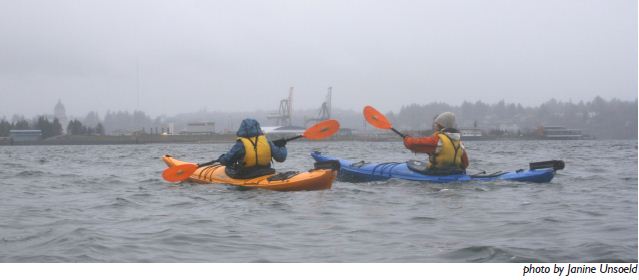Death of Sequalitchew Creek?By Harry Branch
Low Impact Development is an attempt to reduce impervious layers and allow better replenishment of groundwater, reduced runoff during rainy periods and increased stream flow during dry periods. Concrete pavement in parking lots, sidewalks and gutters prevent the entry of rainwater into the ground. As of 2006 there were approximately 357,840 acres of impervious surfaces in the Puget Sound basin, about 4.1 % of the total. Between 1997 and 2007 Washington State lost over 5000 farms totaling 460,000 acres. The percentage of previously farmed that was paved during this time is probably between 8000 and 9000 acres. Concrete is as much as 75% sand and gravel. Gravel is also important because it is the stuff that aquifers are made of. Gravel holds and releases water over time. We're taking gravel out of aquifers to make concrete to seal the tops of aquifers. We've got damage coming and going. There is currently a 320 acre gravel mine just west of Dupont along the bank overlooking Puget Sound. A current proposal would extend the mine 166 acres to the south, adjacent to Sequalitchew Creek, the first creek north of the Nisqually River. Up until now, all the gravel has been above the water table. The expansion will be into the water table so the proposal is to "dewater" the aquifer in order to mine the gravel. Dewatering will lower the water table by 18 inches in the northwest portion of the project near what is today Dupont. The expected outer boundary will include large portions of Edmond Marsh where the water table is predicted to drop between 6 and 12 inches. After the mining is complete, dewateriing will stop and the aquifer will return to pre-mining conditions. Or will it? Won't removing gravel from the aquifer reduce its holding capacity? If we drop the water table in a wetland by 6 to 12 inches it's probably no longer a wetland. If one portion no longer functions as a wetland, how is the rest of the wetland effected? If structure, species composition and other parameters are impacted in one portion, is there a spillover or compounding effect in the rest of the wetland? There will be opportunities coming up during the planning phase of the expansion to comment and ask questions. Sequalitchew Creek flows next to the historic location of Fort Nisqually. Like most freshwater outlets on Puget Sound, the estuary of the creek was inhabited for many years prior to the arrival of Europeans, in this case by an extended family of about 40 known as People of the Sequalitchew. Because of its location, there's a detailed written history of life along Sequalitchew Creek dating all the way back to the days of the Hudson Bay company. Combined with compilations of oral histories and other sources, there is a true baseline. People after we're gone will be able to read about and study Sequalitchew Creek as it existed before our arrival. Sources: Puget Sound Partnership, South Puget Sound News, Tilth Producers, The Sequalitchew Creek Watershed Council, and my favorite book: Fort Nisqually, A Documented History of Indian and British Interaction by Cecelia Svinth Carpenter.
Back to Home page. |

